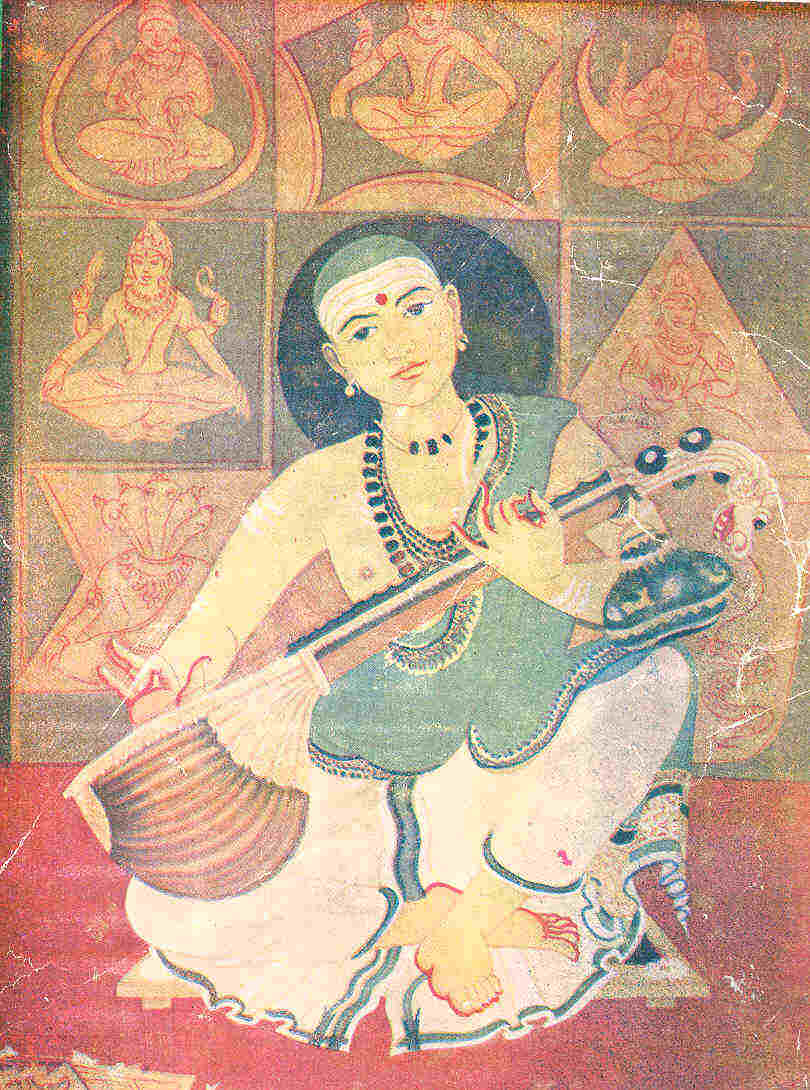Templenet greets visitors on
the occasion of the grand classical music season in Chennai and
celebrates the occasion with this feature on the composer
Dikshitar's tribute to the pancha
bhuta stalas of India.

Not often do you encounter
personalities who create classic works of art that survive
beyond their lifetime.
It is even less often that a composer creates such a classic
that integrates history, tradition and musical sophistry in a
complex and intriguing portrait.
It is even less often that we encounter a composer creating a
group of such classics in a premeditated planned manner that
integrates so many elements of culture, yet showing a thread of
continuity between the individual classics.
The Pancha bhuta stala krits of the revered composer
Muthusvami Dikshitar
are a stunning example of such a portrayal of the stalapuranas
of five distinct temples located
miles apart from one another in South India, primarily in the
Tamil speaking region.
Each phrase in each of these classics has a story to tell; this
feature limits itself to a very brief introduction to each of the kritis and the reference to the five elements.
In his classic chintaya maakanda, Dikshitar venerates
Shiva as Somaskanda
(as the trinity of Shiva, Uma and Skanda) enshrined in
Kanchipuram. Indeed, the juxtaposition of the
Kumarakottam temple in the space
between the Ekamranatha and the
Kamakshi temples is a spatial
illustration of the concept of Somaskanda. It is a known fact
that none of the Shiva temples in Kanchi has a shrine
dedicated to the mother Goddess. A Somaskanda panel
adorns the sancta in a representation of Shakti united with
Shiva along with Skanda. It is in Kanchi that Shiva is venerated
as a representation of the element earth, that
constitutes one of the five bhutas or elements that is vital to
creation. It is in this composition that Dikshitar venerates the
beauty of the image of Shiva in the form of Shiva, with a
beautiful smile and a brilliance that shadows Kama the lord of
Love. The raga mudra is brought out with the phrase 'bhairavi
prasangam' in the madhyama kala phrases of the composition
as is the phrase prithvi lingam.
The kriti Sri Kalahastisa in the raga useni is an
offering to the veneration of Shiva as 'Vayu lingam' and
an acknowledgement of the element 'air' as one of the
five elements that constitutes life. Shiva's consort here is
Jnanaprasunambika and the
shrine at Kalahasti
is considered to be on par with Kailasha (one of the most
revered places of worship in the Saiva tradition). The
reference to the element air comes in the form of sameeraadhaara
(the basis of the element air). The kriti also draws
attention to the stalapurana that celebrates Kannappa
Nayanar's devotion to Shiva. The reference to Shiva as a
personification of nothing other than true bliss (sat chit
anandam) is a theme that occurs both in the prithvi linga
kriti as well as in sri Kalahastisa.
Arunachala Natham is a classic that at once invokes a
sense of majesty associated with the shrine at
Tiruvannamalai.
Shiva is venerated as the Lord of Apitakuchamba (Unna
mulaiyaal). smaraNAt kaivalya (i.e. access to
liberation from the cycle of birth and death upon meditating
upon Tiruvannamalai) is a phrase that marks the beginning
of the anupallavi of the kriti. Again the phrase 'chidanandam'
makes an appearance in this kriti. Shiva is referred to as 'Tejomaya
lingam' (a fiery Shivalingam
as symbolified by the hill and by the annual
kartikai deepam
that is lit at the culmination of the bhrahmotsavam atop
the hill) and the raga mudra 'sarangam' appears in the
phrase 'kara dhrita sarangam' referring to the deer
adorning Shiva's arm.
Jambu Pate is a classic in the raga Yamuna Kalyani
and it has reference to the water bodies such as Yamnua,
Ganga, Kaveri, the ocean and it
venerates Shiva as pancha bhuta maya prapancha prabhu. It
also refers to the legend of the elephant that renders the name
Tiruvaanaikkaval to the town,
through the phrase 'saamajaatavi'. Again, Shiva is referred to
as the personification of true bliss (nijaananda).
The fifth in the series of these kritis is Ananda Natana
Prakasam in the raga kedaram. Set at a leisurely pace
(as are the rest of the kritis), this kriti in a seven beat
cycle salutes the brilliance of the
cosmic dance of the Universe and the cosmic dancer
Shiva, the Lord of the chit sabha.
Needless to say, the theme of supreme bliss occurs right away as
the opening phrase of the kriti extoling the glory of the
hoary temple at Chidambaram.
It is in this kriti that an explicit reference to the non dual
nature of existence (advaita pratipaadyam) occurs, although this
nature of being has been implicitly referred to in the other
kritis. The phrase daharaakaasam refers to the fifth
element aakaasha or space.
Listening to a dignified rendition of these kritis is a
profound experience, especially if one keeps in mind the
significance behind the traditions associated with the five
temples that have survived the test of time, a one of a kind
grouping of monuments that are linked in so many different ways
not seen elsewhere in the world.
The
author Kanniks Kannikeswaran is scheduled to present
'Nottusvara
Sahityas of Muthusvami Dikshitar' - a lecture
demonstration at the Music Academy, Chennai during this music
season.